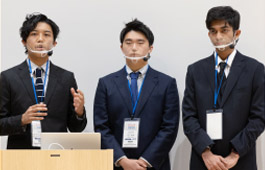
左から
タンポール カンガス スカイ Tampol Cangas Sky
国際教養大学 国際教養学部 2年
石戸 凜太郎 Ishito Rintaro
国際教養大学 国際教養学部 2年
ラーマン アリアン Rahman Arian
国際教養大学 国際教養学部 2年
Rahman Arian
Good afternoon, this is Rintaro, this is Sky and I am Arian. And today we will be speaking about how to bring investment to the masses.
However, before all else, I would like to ask you a question. That question is “Is investment important?“
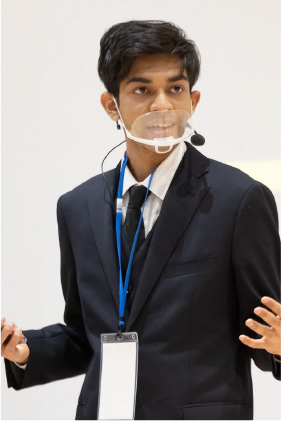
I would argue yes. Through investment, individuals are able to increase their wealth. This is more important in modern-day Japan because Japan had very low-interest rates, low wage growth, and a frankly unreliable pension system. It is up to us to ensure ourselves a comfortable life during our sunset years. Investment is a very effective way to accomplish this.
Moreover, the benefits of investment are not merely personal. You see, investment allows us to empower good ideas and reward them. If it were not for the investment, we would not be able to see great ideas such as the microchip and life-changing apps that we use on a daily basis come to flourishing. Investment is what brings innovation to our society.
That being said, we tend to see investment as something out of our realm. We tend to think that investment is only for professionals, especially in Japan. As a result, Japan has very low retail investor activity. Now I would like to bring my friend Sky to the stage to elaborate on this issue.
Tampol Cangas Sky
Thank you, Arian. Investment is low in Japan. Let's take a look at the actual numbers. These numbers are the possession rates of stocks and investment trusts. From the global comparison, we can see that Japanese people are less likely to hold stocks and investment trusts to invest their money.
Here we have two pie charts about the brokerage account holders by age group. The left one is the ratio of SBI's brokerage account holders by age group. SBI is the largest security firm in the domestic market. This chart shows that under 30 remains quite low at 8.5%. We can see the same trend in the other pie chart as well, which is about online brokerage accounts by age group, and under 30 is ONLY 5.9%.
This is more than enough to prove how young Japanese people are not into investment. What is problematic here from these slides is that young Japanese people are particularly unwilling investors even in the globally low-investing-minded Japanese population.
We think that this issue could be partly attributed to a lack of financial literacy in Japanese society.
Here are the average scores of financial literacy tests conducted by Central Council for Financial Services Information. Looking at the bar charts, it is too obvious that the youngest age group from 18 to 29 has the worst average scores, indicating that low financial literacy is most serious issue in the youngest generations.
Here's the follow-up survey of the same financial literacy tests. Actually, before the test was conducted, one group received financial education like how to manage money, basic accounting and financing. This chart shows that 67.3% of the participants said that financial education should be conducted after they actually experienced it. Also, it should be noted that out of those respondents, only 8.5% answered that they had received the same kind of financial education before.
In other words, a lot of Japanese people have never received financial education before, but after they learned what financial education was, they thought it was necessary for the Japanese curriculum.
We are going to suggest a practical application for financial education at Japanese high school. For that, we have three key components, education, technology, and investment. We came up with this application and named it "UPVEST" because the objective of this app is to educate the youth on investment to increase financial literacy in Japan.
This is a simulation application where students can practice investment. In the game, they start off with 100,000 points equaled to 100,000 JPY for the virtual market. Another game setting is that they compete with other algorithm-based investors in the virtual market. Lastly, the movement of stock markets is based on the real financial market, thus users naturally get up to speed on economic news, which is also good for financial literacy.
How to play the game is pretty straightforward. First, they investigate financial instruments, and make transactions. If they buy low and sell high, they can maximize their allocated points, their profits. Last but not least, what is also good about this app is transferability. The allocated points in the game can be transferred to actual JPY when students open their brokerage accounts once they turn 20.
We plan that the rate of transfer should be around 100 points equal to 1 actual JPY. Based on this calculation, if students keep their allocated points as they are from the beginning, they are going to have 1000 yen in their brokerage accounts when they open them.
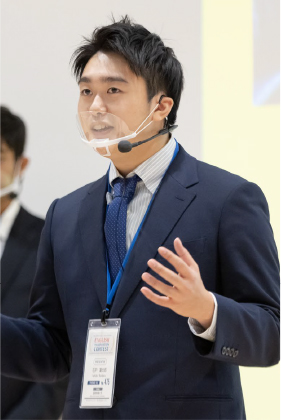
Ishito Rintaro
How can we utilize this in the educational field? According to an educational guideline of high schools in 2022, investment education will be provided in the course of home economics from next year. As there have been few practical materials to learn about investment, this app plays an important role in bringing students actual investment experience in the future class of home economics.
In addition, it is said that over 90% of high school students possess smartphones and the GIGA school program aimed at providing each student with a digital device is now proceeding. Under these circumstances, students are allowed to work on this app even outside of their classrooms, having a lot of chances to be exposed to the investment world.
So, what benefits can we expect to our plan? First of all, contributing to the creation process of our educational material is a crucial marketing opportunity for brokerage companies to advertise their works especially among younger generations. As a consequence, there will be an increase in the number of young clients.
In addition, our investment app is expected to boost the financial literacy of young generations. Society will also be blessed with economic growth and clarified corporate governance attributed to the increase of investment.
In order to realize our plan, cooperation among these three elements is indispensable.
Brokerage companies take an initiative in creating a set of the app. Discussing with the ministry of education to what extent replicates the investment world in the app and demand from higher education, they form a foundation of the app.
Software engineers actually design the app based on the discussion between brokerage companies and the ministry of education. Production of the app is estimated to cost about 4 million yen in total.
The ministry of education invests in the creation of the app as digital learning material. After an accreditation by the ministry of education, it's time to introduce the app in the classroom, motivating more students to get familiar with the investment.
Rahman Arian
Finally, I want to end with one thought. And that is that investment is not just investment. The act of investment can be distilled into the act of synthesizing information to make smart decisions. It requires a special eye for good information and an equally effective action plan to make use of that information.
I see this as a transferable skill that more people should have especially in the information age. We are making children learn to program because so many of us think that it will be a useful skill for children. What makes investment so different? Let us invest in the future of children and society through investment.
Thank you for your attention.
ラーマン
こんにちは。凛太郎、スカイ、そして私はアリアンです。本日はいかに投資を大衆に広めるかについてお話します。
まずみなさんに質問です。投資は重要でしょうか?
私の意見はYESです。 投資によって、個人はその資産を増やすことができます。これは現代の日本においてとても重要なことです。なぜなら、日本は極めて金利が低く、賃金の上昇率も低く、率直に言えば年金制度が不安定だからです。老後に快適な暮らしを送ることを確実にできるかは私たち自身にかかっているのです。投資はこの目標を達成するのにとても効果的な手段です。
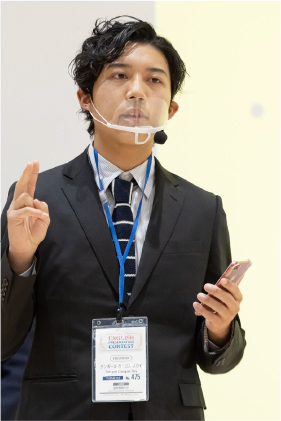
さらに言えば、投資の利点は個人に限定されるものではありません。ご存知の通り、良き考えを後押しし、 報酬を与えることができます。投資がなければ、マイクロチップや人生を変えるようなアプリなど現在の生活で基本となっている素晴らしいアイデアがここまで繁栄している様子にもお目にかかれなかったことでしょう。投資は私たちの社会にイノベーションをもたらすのです。
私たちは、投資は自分たちの領域のものではないと考えがちであると言われています。とりわけ日本では、投資は専門家だけのものと考えられがちです。結果として、日本では一般投資活動がとても低調です。では、この問題について詳しく述べてくれる私の友人、スカイをステージに呼びましょう。
タンポール
ありがとう、アリアン。日本では投資が少ないです。実際の数値を見ていきましょう。これらの数字は、株式および投資信託の保有率です。国際比較をすると、日本人は株式や投資信託の保有に対して自分の資金を投資することが非常に少ないことが分かります。
ここに2つの円グラフがあります。年代ごとの証券会社の口座保有者数です。左側はSBIの年代ごとの口座保有者数です。SBIは日本の国内市場では最大手の証券会社です。このグラフでは、30歳以下が8.5%と非常に低いことがわかります。もうひとつの円グラフはインターネットの証券会社の年代ごとの口座保有者数です。こちらも30歳以下は5.9%と非常に低いです。
日本の若い世代が投資をしていないかが立証できました。これらのスライドで分かる問題は、世界的に見ても日本人は投資への意識が低いですが、とりわけ若い日本人が特に投資に対して積極的ではないことです。
この問題の原因のひとつは、日本社会において金融リテラシーが欠如していることだと私たちは考えました。
ここに金融広報中央委員会が実施した金融リテラシー試験の平均点があります。棒グラフを見ると、18歳から29歳の最も若いグループは平均点が最も悪いことが明らかです。これにより、若い世代での金融リテラシーの低さが最も深刻な問題であることが分かります。
ここに金融リテラシーの同じ試験の追跡調査があります。試験を受ける前に、あるグループはお金の管理や基本的な会計や金融に関する金融教育を受けました。このグラフでは、その教育を実際に受けた参加者のうち67.3%が金融教育は実施されるべきだと答えています。特筆すべきは、そう回答した人々のうち、同様の金融教育をこれまで受けたことのある人々わずか8.5%の人々だったということです。
言い換えれば、実に多くの日本人は金融教育を受けたことがなく、しかし、金融教育が何であるかを学んだのちには、日本の教育課程において必要だと考えるのです。
私たちは、日本の高校における金融教育のための実践的なアプリケーションを提案していきます。これには、3つの構成要素があります。教育、技術、投資です。私たちはこのアプリケーションを考え、「アップベスト(UPVEST)」と名付けました。このアプリは、若者に投資(invest)に関する教育を行い、日本における金融リテラシーを高める(up)が目的だからです。
これは生徒たちが投資を実践できるシミュレーションアプリです。ゲームでは、10万ポイントから始めますが、これは仮想市場での日本円10万円に相当します。他のゲーム設定としては、生徒たちは仮想市場においてアルゴリズムによって生成される投資家と競います。株式市場の変動は現実の金融市場と連動しており、ユーザーは自然に経済ニュースに敏感になります。それもまた金融リテラシーを高めるうえで有効です。
ゲームのプレイ方法は極めて簡単です。まず、金融投資に関して調査をし、市場で取引をします。安く買って、高く売れれば、割り当てられたポイント、つまり利益を最大化することができます。もうひとつ大切なのは、ことアプリの利点は移動性です。このゲームでは生徒が20歳になって証券会社の口座を開いたときに割り当てのポイントを日本円に換金できるのです。
換金のレートは、100ポイントを1円とすることを計画しています。この計算に基づくと、もし、生徒が最初からの割り当てポイントを維持していたとしたら、証券会社口座を開いたときに1000円を手に入れることができます。
石戸
では、教育現場でいかにこのアプリを活用できるでしょうか? 2022年の高等学校における学習指導要領では、投資教育は家庭科の授業で来年より実施されることになっています。投資について学ぶための実践的な教材がほとんどなかったので、このアプリは、将来的に家庭科の授業で実際の投資体験が得られる重要な役割を果たすことになるでしょう。
加えて、90%の高校生がスマートフォンを所有していると言われており、1人に1台のデジタル機器を提供するGIGAスクールプログラムが進行しています。こういった環境において、生徒たちは学校の外でもこのアプリに取り組むことができ、投資の世界に触れるとても多くの機会を得られるのです。
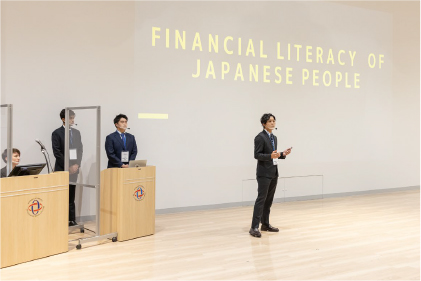
では、この計画によってどのような恩恵が得られるでしょうか?まず、私たちの教材に貢献することは、証券会社にとって極めて重要なマーケティングの機会になり、若い世代に証券会社の仕事を宣伝することができます。結果として、若い世代の顧客を増やせるのです。
加えて、私たちの投資アプリは、若い世代の金融リテラシーを高めることが期待できます。社会は経済成長の恩恵を受け、投資の増加によって、コーポレートガバナンスの質の向上も期待できます。
私たちの計画を実現するために、次の3つの要素の協力が不可欠です。
証券会社は一連のアプリを開発するうえで主導します。文部科学省とアプリの中でどの範囲まで投資の世界を再現するか、そして高等教育からの需要を議論したうえで、アプリの基礎を形成します。
ソフトウェアのエンジニアは、証券会社と文部科学省と議論を踏まえて、実際の設計を行います。アプリの制作にはおよそ400万円の費用を見込んでいます。
文部科学省は、デジタル学習の教材としてアプリの開発に投資します。文部科学省の認可を経たのち、より多くの生徒たちが投資を身近に感じられることを後押しするアプリが授業に導入されるのです。
ラーマン
最後に、ある考えで締めたいと思います。投資は単なる投資ではない。投資の行動は、根本的には情報を総合して、スマートな判断を下すための行動であると要約できるのです。そのためには、良い情報への特別な目が必要であり、同時にその情報を使うための有効な行動計画が必要です。
これは、情報社会に生きる多くの人々にとって、応用可能なスキルであると私は理解しています。 私たちは子どもたちが学ぶプログラムを作成しますが、その目的はプログラムが子どもたちにとって役立つスキルだと私たちの多くが考えているからです。では、投資は一体何が違うというのでしょうか。投資を通じて、子どもたちと社会の未来に投資をしましょう。
ご静聴ありがとうございました。